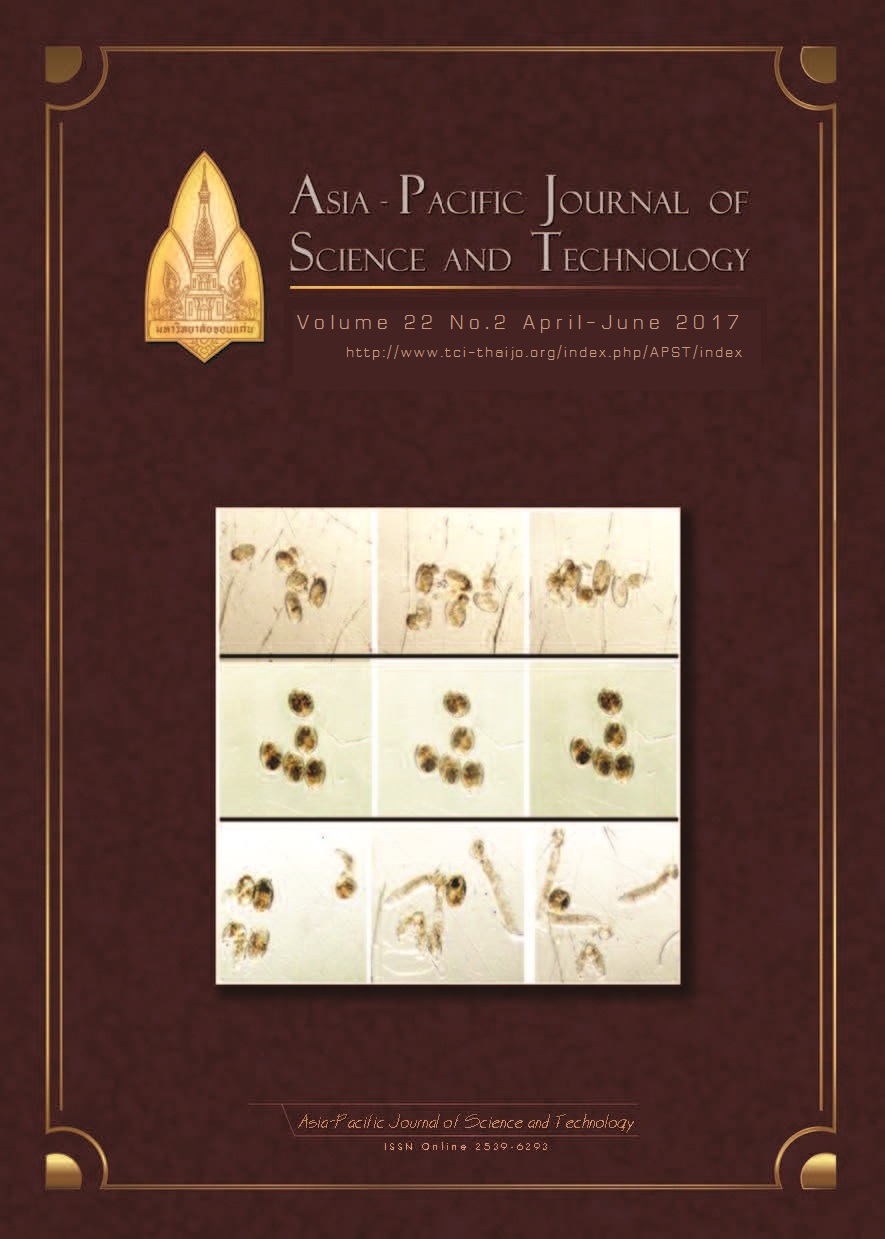Hibiscus sabdariffa Linn. calyx extraction and Gallic acid improving cardiac diastolic dysfunction in high fat diet-STZ-induced type 2 diabetic rats
Main Article Content
Abstract
Objective: Cardiovascular disease one of the serious complications of chronic diabetes. We previously reported on the ability of roselle (Hibiscus sabdariffa Linn.) water extract (HS-WE) to improve vascular response in rats suffering from chronic diabetes. The objective of this study was to investigate the effects of HS-WE and gallic acid on ventricular function in high fat diet‑streptozotocin (HFD-STZ)-induced Type 2 diabetic rats.
Material and Methods: Male Sprague-Dawley rats were used. The normal control group was fed normal rat chow. Diabetic groups were fed a HFD for four weeks, followed by intraperitoneal injections of STZ 30 mg/kg. The diabetic rats were divided into five groups that were orally administered daily with distilled water, 50% propylene glycol, HS-WE (500 mg/kg), gallic acid (50 mg/kg), and metformin (200 mg/kg) for a further eight weeks. At the end of all treatments, the levels of fasting blood glucose (FBG), serum insulin, Homeostatic Model Assessment-Insulin Resistance (HOMA-IR), plasma and heart malondialdehyde (MDA), heart superoxide production and left ventricular function were determined.
Results: Diabetic control rats showed significant increases in levels of FBG, HOMA-IR, MDA and superoxide production. In the left ventricular function examination, an increase in diastolic ventricular pressure (DVP) and a decrease in (-)dP/dt (p<0.05) were observed. Interestingly HS-WE and gallic acid treated groups had significant decreases in FBG, HOMA-IR, plasma MDA, heart MDA and heart superoxide production as well as a decrease in DVP and an increase in (-)dP/dt when compared to the diabetic control group (p<0.05).
Conclusion: These results indicated that HS-WE and gallic acid improved diabetic induced diastolic dysfunction and this effect may have been mediated via their antioxidant activities.
Article Details
References
[2] Falcao-Pires, I., Leite-Moreira, A.F., 2012. Diabetic cardiomyopathy: understanding the molecular and cellular basis to progress in diagnosis and treatment. Heart Failure Reviews 17, 325-344.
[3] Liu, J.-W., Liu, D., Cui, K.-Z., Xu, Y., Li, Y.-B., Sun, Y.-M., Su, Y., 2012. Recent advances in understanding the biochemical and molecular mechanism of diabetic cardiomyopathy. Biochemical and Biophysical Research Communications 427, 441–443.
[4] Hopkins, A.L., Lamm, M.G., Funk, J.L., Ritenbaugh, C., 2013. Hibiscus sabdariffa L. in the treatment of hypertension and hyperlipidemia: a comprehensive review of animal and human studies. Fitoterapia 85, 84-94.
[5] Huang, T.W., Chang, C.L., Kao, E.S., Lin, J.H., 2015. Effect of Hibiscus sabdariffa extract on high fat diet-induced obesity and liver damage in hamsters. Food & Nutrition Research 59, 29018.
[6] Ochani, P.C., D'Mello, P., 2009. Antioxidant and antihyperlipidemic activity of Hibiscus sabdariffa Linn. leaves and calyces extracts in rats. Indian Journal of Experimental Biology 47, 276-282.
[7] Yang, M.Y., Peng, C.H., Chan, K.C., Yang, Y.S., Huang, C.N., Wang, C.J., 2010. The hypolipidemic effect of Hibiscus sabdariffa polyphenols via inhibiting lipogenesis and promoting hepatic lipid clearance. Journal of Agricultural and Food Chemistry 58, 850-859.
[8] Lin, H.H., Chen, J.H., Wang, C.J., 2011. Chemopreventive properties and molecular mechanisms of the bioactive compounds in Hibiscus sabdariffa Linne. Current Medicinal Chemistry 18, 1245-1254.
[9] Mantruad A, P.P., Kongyingyoes, B., Kukongviriyapan, U., Chuanta, S., Nakmareong, S., Itharat, A., 2010. Roselle extract and gallic acid improve vascular reactivity of diabetic rats. Srinagarind Medical Journal 25 (Suppl), 257-61.
[10] Wisetmuen, E., Pannangpetch, P., Kongyingyoes, B., Kukongviriyapan, U., Yutanawiboonchai, W., Itharat, A., 2013. Insulin secretion enhancing activity of roselle calyx extract in normal and streptozotocin-induced diabetic rats. Pharmacognosy Research 5, 65-70.
[11] Naowaboot, J., Somparn, N., Saentaweesuk, S., Pannangpetch, P., 2015. Umbelliferone Improves an Impaired Glucose and Lipid Metabolism in High-Fat Diet/Streptozotocin-Induced Type 2 Diabetic Rats. Phytotherapy Research
[12] Luangaram, S., Kukongviriyapan, U., Pakdeechote, P., Kukongviriyapan, V., Pannangpetch, P., 2007. Protective effects of quercetin against phenylhydrazine-induced vascular dysfunction and oxidative stress in rats. Food and Chemical Toxicology 45, 448-455.
[13] Naowaboot, J., Pannangpetch, P., Kukongviriyapan, V., Kukongviriyapan, U., Nakmareong, S., Itharat, A., 2009. Mulberry leaf extract restores arterial pressure in streptozotocin-induced chronic diabetic rats. Nutrition Research 29, 602-608.
[14] Donpunha, W., Kukongviriyapan, U., Sompamit, K., Pakdeechote, P., Kukongviriyapan, V., Pannangpetch, P., 2011. Protective effect of ascorbic acid on cadmium-induced hypertension and vascular dysfunction in mice. Biometals 24, 105-115.
[15] Bansal, P., Paul, P., Mudgal, J., Nayak, P.G., Pannakal, S.T., Priyadarsini, K.I., Unnikrishnan, M.K., 2012. Antidiabetic, antihyperlipidemic and antioxidant effects of the flavonoid rich fraction of Pilea microphylla (L.) in high fat diet/streptozotocin-induced diabetes in mice. Experimental and Toxicologic Pathology: Official Journal of the Gesellschaft Fur Toxikologische Pathologie 64, 651–658.
[16] Giacco, F., Brownlee, M., 2010. Oxidative stress and diabetic complications. Circulation Research 107, 1058-1070.
[17] Aneja, A., Tang, W.H., Bansilal, S., Garcia, M.J., Farkouh, M.E., 2008. Diabetic cardiomyopathy: insights into pathogenesis, diagnostic challenges, and therapeutic options. American Journal of Medicine 121, 748-757.
[18] Fang, Z.Y., Prins, J.B., Marwick, T.H., 2004. Diabetic cardiomyopathy: evidence, mechanisms, and therapeutic implications. Endocrine Reviews 25, 543-567.
[19] Li, X., Xu, Z., Li, S., Rozanski, G.J., 2005. Redox regulation of Ito remodeling in diabetic rat heart. American Journal of Physiology-Heart and Circulatory Physiology 288, H1417-1424.
[20] Rodrigues, B., Cam, M.C., McNeill, J.H., 1998.Metabolic disturbances in diabetic cardiomyopathy. Mol Cell Biochem. 180, 53-57.
[21] Da-Costa-Rocha, I., Bonnlaender, B., Sievers, H., Pischel, I., Heinrich, M., 2014. Hibiscus sabdariffa L. - a phytochemical and pharmacological review. Food Chemistry 165, 424-443.
[22] Micucci, M., Malaguti, M., Gallina Toschi, T., Di Lecce, G., Aldini, R., Angeletti, A., Chiarini, A., Budriesi, R., Hrelia, S., 2015. Cardiac and Vascular Synergic Protective Effect of Olea europea L. Leaves and Hibiscus sabdariffa L. Flower Extracts. Oxidative Medicine and Cellular Longevity 2015, 318125.

